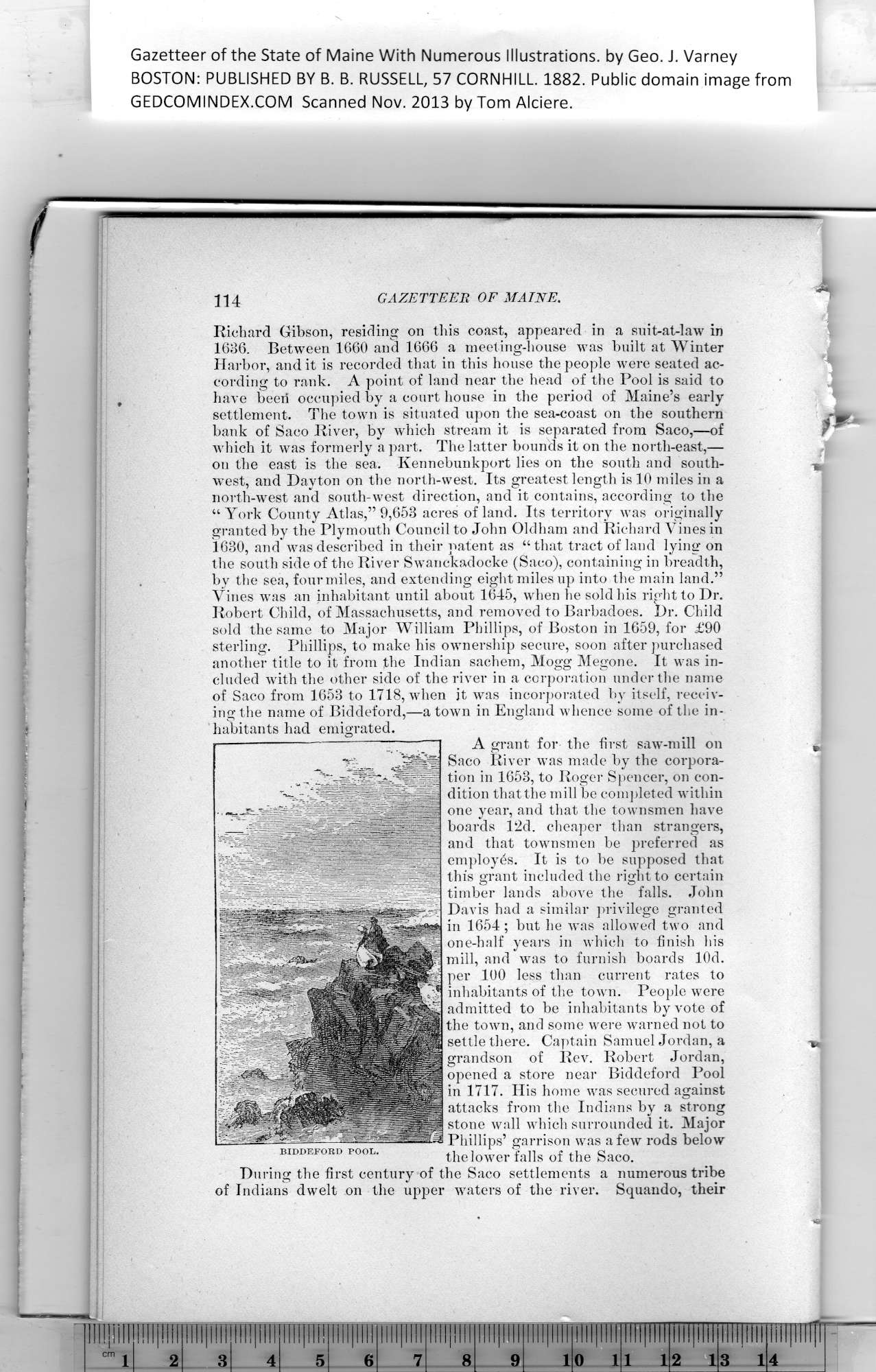|
Gazetteer of the State of Maine With Numerous Illustrations, by Geo. J. Varney
BOSTON: PUBLISHED BY B. B. RUSSELL, 57 CORNHILL. 1882. Public domain image from
114 GAZETTEER OF MAINE.
Richard Gibson, residing on this coast, appeared in a suit-at-law in
1636. Between 1660 and 1666 a meeting-house was built at Winter
Harbor, and it is recorded that in this house the people were seated ac-
cording to rank. A point of land near the head of the Pool is said to
have been occupied by a court house in the period of Maine’s early
settlement. The town is situated upon the sea-coast on tbe southern
bank of Saco River, by which stream it is separated from Saco,—of
which it was formerly a part. The latter bounds it on tbe north-east,—
on tbe east is the sea. Kennebunkport lies on tbe south and south-
west, and Dayton on the north-west. Its greatest length is 10 miles in a
north-west and south-west direction, and it contains, according to the
“York County Atlas,” 9,653 acres of land. Its territory was originally
granted by the Plymouth Council to John Oldham and Richard Vines in
1630, and was described in their patent as “that tract of land lying on
the south side of the River Swanckadocke (Saco), containing in breadth,
bv the sea, four miles, and extending eight miles up into the main land.”
Vines was an inhabitant until about 1645, when he sold his right to Dr.
Robert Child, of Massachusetts, and removed to Barbadoes. Dr. Child
sold the same to Major William Phillips, of Boston in 1659, for £90
sterling. Phillips, to make his ownership secure, soon after purchased
another title to it from the Indian sachem, Mogg Megone. It was in-
cluded with the other side of the river in a corporation under the name
of Saco from 1653 to 1718, when it was incorporated by itself, receiv-
ing the name of Biddeford,—a town in England whence some of the in-
habitants had emigrated.
A grant for the first saw-mill on
Saco River was made by the corpora-
tion in 1653, to Roger Spencer, on con-
dition that the mill be completed within
one year, and that the townsmen have
boards 12d. cheaper than strangers,
and that townsmen be preferred as
employes. It is to be supposed that
this grant included the right to certain
timber lands above the falls. John
Davis had a similar privilege granted
in 1654 ; but he was allowed two and
one-half years in which to finish his
mill, and was to furnish boards lOd.
per 100 less than current rates to
inhabitants of the town. People were
admitted to be inhabitants by vote of
the town, and some were warned not to
settle there. Captain Samuel Jordan, a
grandson of Rev. Robert Jordan,
opened a store near Biddeford Pool
in 1717. His home was secured against
attacks from the Indians by a strong
stone wall which surrounded it. Major
Phillips’ garrison was a few rods below
the lower falls of the Saco.
During the first century of the Saco settlements a numerous tribe
of Indians dwelt on the upper waters of the river. Squando, their
PREVIOUS PAGE ... NEXT PAGE
This page was written in HTML using a program written in Python 3.2
|
